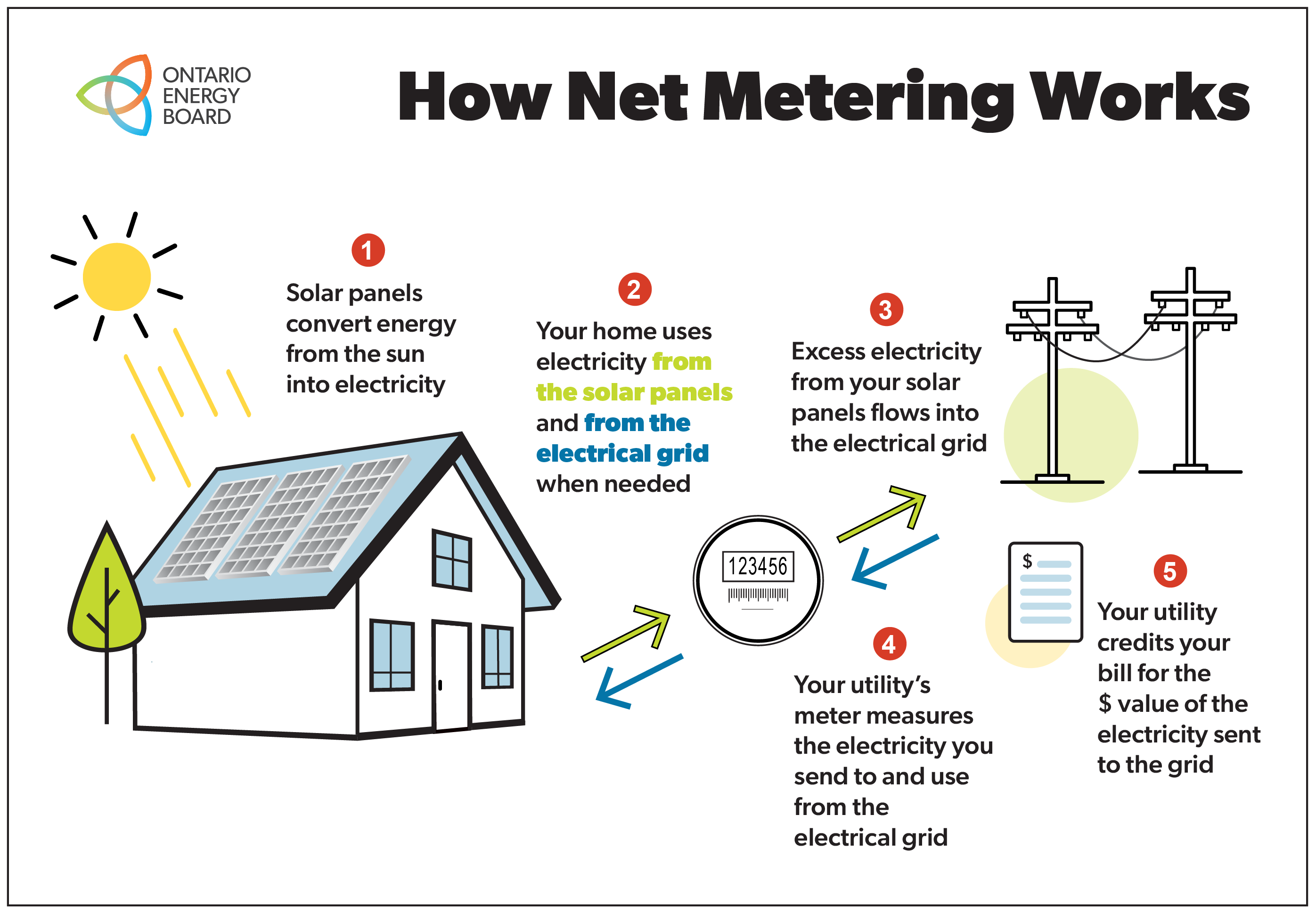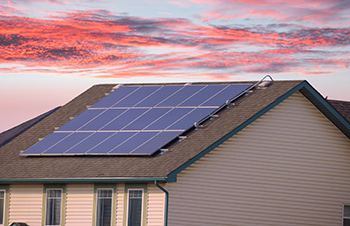The Net Metering program is established by the Ministry of Energy and is governed by the Regulation O. Reg. 541/05: NET METERING. This regulation sets the rules for eligibility, technical requirements, financial calculations, and other administrative procedures for net metering.
Before investing in or making arrangements for a renewable energy system for net metering purposes, check with your electricity utility to confirm that you are eligible and that the renewable energy system can be connected to their grid.
How net metering works
- Renewable energy systems generate electricity from renewable sources. For example, solar panels convert energy from the sun into electricity.
- Your home or business uses electricity from the renewable energy system and your utility’s electricity grid when needed.
- When the renewable energy system produces more electricity than you can use, the excess electricity flows into your utility’s grid.
- Your utility measures the electricity you use from, and send to, their grid.
- Your utility bills you for the electricity you consume from their grid, and gives you a credit on your electricity bill in return for the renewable electricity you sent to the grid. These credits can only be used to offset charges related to your electricity consumption (i.e., kWh of electricity you consumed) and cannot be applied to other types of charges on your bill.
NOTE: Per section 8 (8) of the Net Metering Regulation, credits can only be carried over to future bills for up to 12 months, after which credits are reduced to $0.

To be eligible for net metering, you must be generating renewable electricity primarily for your own use. You will have to enter into a net metering agreement with your utility to send any excess renewable electricity to their grid in exchange for on-bill credits. You will also need to apply to your utility to connect the renewable energy system to their grid and meet their technical, safety and inspection requirements. And a reminder, before investing in or making arrangements for a renewable energy system for net metering purposes, contact your utility to confirm that you’re eligible and that the renewable energy system can be connected to their grid.
You can choose to buy your renewable energy system outright, or lease or finance it from a third party, including an electricity retailer. If you are planning to contract with an electricity retailer for the renewable energy system and to buy the electricity generated by the renewable energy system from the electricity retailer, the electricity retailer will ask you to enter into 2 separate agreements – a Power Purchase Agreement (PPA) for the purchase of electricity generated by the renewable energy system and an Associated Equipment Agreement (AEA) for the renewable energy system itself (these agreements are explained below).
Please note that the OEB does not set prices in a PPA or AEA. There is also no term limit for PPAs and AEAs. Before signing a PPA or an AEA, make sure you understand what you will pay, your other rights and responsibilities under each of those agreements, and how long each of those agreements will last.
How net metering works with a Power Purchase Agreement
Power Purchase Agreements
A PPA is a contract with an electricity retailer for the purchase of the electricity generated by the renewable energy system. This would be for the electricity you use for your home or business and from which the excess electricity is sent to your utility’s grid for a credit. The PPA must include OEB-approved plain language standard terms and conditions for residential and business customers, with other provisions to be filled in by the electricity retailer.
A few things to know about PPAs:
- If you sign a PPA, you will still receive a bill from your utility for the electricity that you use from the utility’s grid, as well as for other charges like delivery and taxes.
- A PPA may not save you money. Review the terms of the PPA carefully. Read the Price Comparison that comes with the PPA to help you understand how entering into the PPA can affect some of your electricity costs.
- No one can sign you up for a PPA while they’re at your home.
The electricity retailer is required to provide you with a Disclosure Statement and a Price Comparison (residential or business) in the form approved by the OEB. These documents must be provided to you with the PPA, and you should read them carefully before signing the PPA.
If you sign a PPA, the electricity retailer will contact you 10 to 45 days after that to verify that you wish to continue with it. If you don’t want to continue with the PPA, you can say so. You will not have to pay a cancellation fee.
You can cancel a PPA with no penalty associated with the PPA itself:
- within 10 days after signing the PPA
- within 30 days after you receive your second bill under the PPA. You will still have to pay that bill.
You can cancel the PPA at any time after that, but there may be a cancellation fee. Review your PPA carefully for all cancellation details.
Cancellation of the PPA at any time may result in penalties or fees under the AEA.
Associated Equipment Agreements
An AEA is a contract for a renewable energy system that is offered by an electricity retailer in association with their PPA. An AEA can take different forms – for example, it can be a leasing agreement. The AEA is associated with, but separate from, the PPA.
The OEB does not regulate any of the terms or conditions contained in AEAs. If you enter into an AEA, you may have to pay fees or penalties under that agreement if you do not enter into the associated PPA or cancel the associated PPA. Before entering into an AEA, make sure you receive and review the associated PPA. In addition to the provisions relating to the purchase of electricity, the associated PPA must also include certain information about the AEA, including payment terms, options or obligations to purchase the renewable energy system, and any obligations you may have to maintain and operate that system.
Before entering into an AEA, here are some questions you may want to ask:
- If I cancel the AEA, will I have to pay a fee or penalty?
- What happens to the renewable energy system if I move?
- Who is liable if something happens to the renewable energy system?
- Who is responsible for maintaining and repairing the renewable energy system, or for any damage that the renewable energy system may cause to my property?
- How much electricity will the renewable energy system produce, and how was that determined? Keep in mind that the amount of electricity generated by a renewable energy system is variable, and that changes in your environment can have a long-term effect on that amount. For example, shade from a new tree or a new building can reduce electricity production.
Carefully review the AEA before you sign it, including the cancellation provisions and penalties or fees. Visit Consumer Protection Ontario to learn more about your rights before, during and after you sign a contract.
Know your rights and responsibilities
If you are approached about entering into a PPA or an AEA, take the time to make sure you understand your rights and responsibilities.
- You don’t need to rush into any agreements. Your utility will always provide you with electricity, whether or not you enter into a PPA.
- Your energy bill is private. It contains personal information like your account number and energy usage. You do not have to provide your energy bill to a salesperson for an electricity retailer if you don’t want to.
- A salesperson for an electricity retailer must give you a business card and show their company ID badge.
- Electricity retailers are not your utility, the government or the OEB.
Still have questions?
Contact us or your electricity utility.
For more information on the Net Metering Program, visit the Ontario Ministry of Energy’s website.
